Legislative Framework Assignment Report
VerifiedAdded on 2022/08/25
|11
|2926
|19
AI Summary
Contribute Materials
Your contribution can guide someone’s learning journey. Share your
documents today.
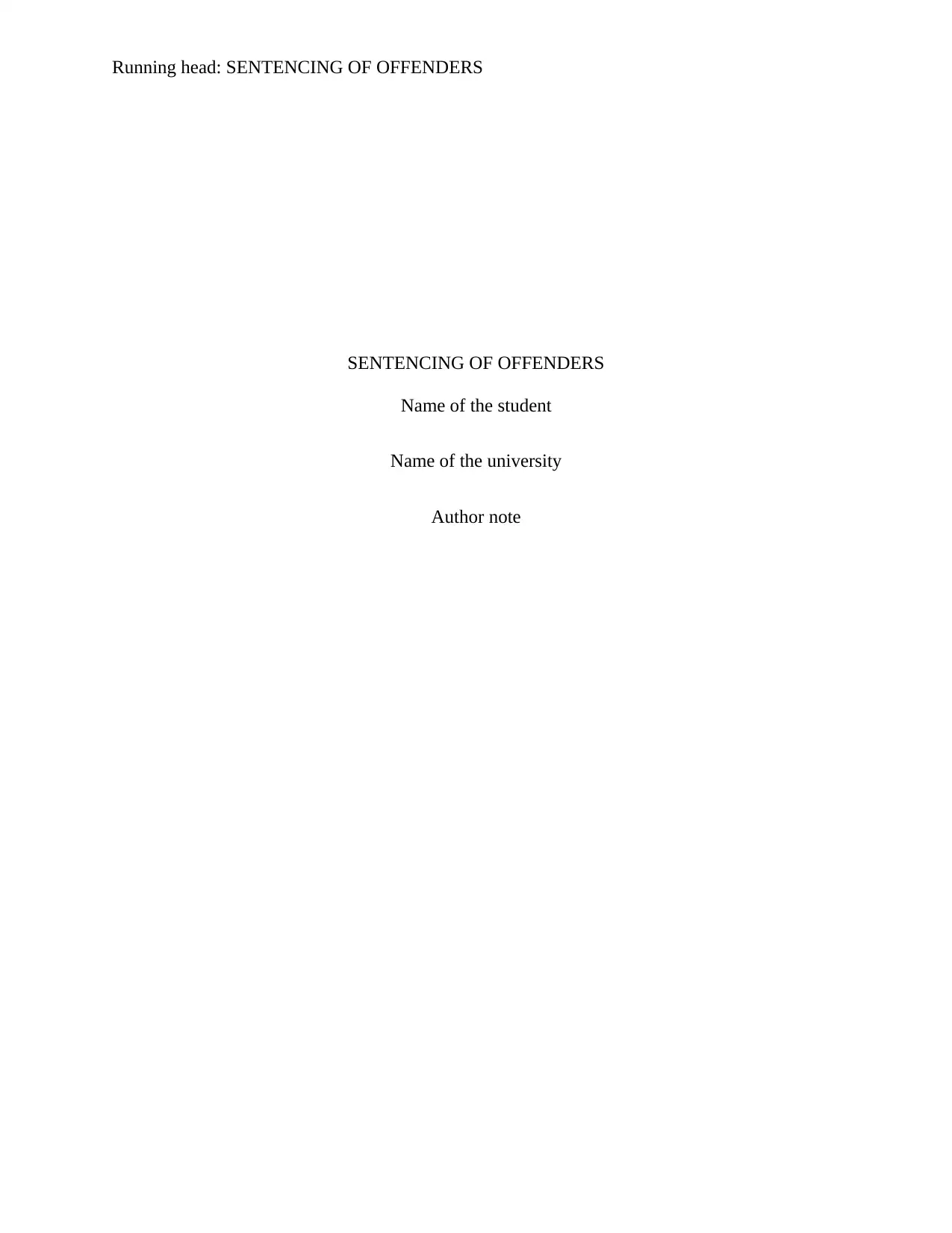
Running head: SENTENCING OF OFFENDERS
SENTENCING OF OFFENDERS
Name of the student
Name of the university
Author note
SENTENCING OF OFFENDERS
Name of the student
Name of the university
Author note
Secure Best Marks with AI Grader
Need help grading? Try our AI Grader for instant feedback on your assignments.
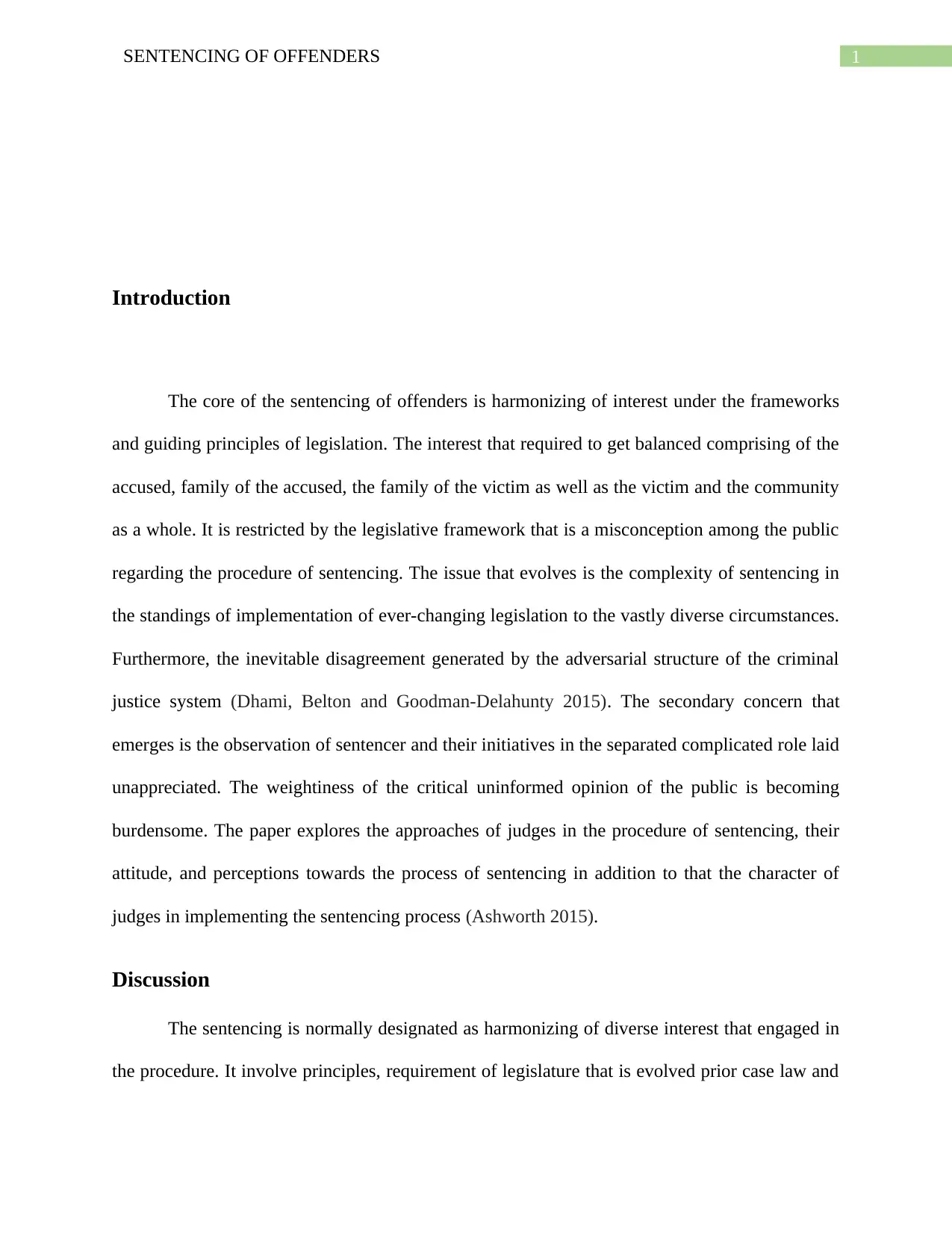
1SENTENCING OF OFFENDERS
Introduction
The core of the sentencing of offenders is harmonizing of interest under the frameworks
and guiding principles of legislation. The interest that required to get balanced comprising of the
accused, family of the accused, the family of the victim as well as the victim and the community
as a whole. It is restricted by the legislative framework that is a misconception among the public
regarding the procedure of sentencing. The issue that evolves is the complexity of sentencing in
the standings of implementation of ever-changing legislation to the vastly diverse circumstances.
Furthermore, the inevitable disagreement generated by the adversarial structure of the criminal
justice system (Dhami, Belton and Goodman-Delahunty 2015). The secondary concern that
emerges is the observation of sentencer and their initiatives in the separated complicated role laid
unappreciated. The weightiness of the critical uninformed opinion of the public is becoming
burdensome. The paper explores the approaches of judges in the procedure of sentencing, their
attitude, and perceptions towards the process of sentencing in addition to that the character of
judges in implementing the sentencing process (Ashworth 2015).
Discussion
The sentencing is normally designated as harmonizing of diverse interest that engaged in
the procedure. It involve principles, requirement of legislature that is evolved prior case law and
Introduction
The core of the sentencing of offenders is harmonizing of interest under the frameworks
and guiding principles of legislation. The interest that required to get balanced comprising of the
accused, family of the accused, the family of the victim as well as the victim and the community
as a whole. It is restricted by the legislative framework that is a misconception among the public
regarding the procedure of sentencing. The issue that evolves is the complexity of sentencing in
the standings of implementation of ever-changing legislation to the vastly diverse circumstances.
Furthermore, the inevitable disagreement generated by the adversarial structure of the criminal
justice system (Dhami, Belton and Goodman-Delahunty 2015). The secondary concern that
emerges is the observation of sentencer and their initiatives in the separated complicated role laid
unappreciated. The weightiness of the critical uninformed opinion of the public is becoming
burdensome. The paper explores the approaches of judges in the procedure of sentencing, their
attitude, and perceptions towards the process of sentencing in addition to that the character of
judges in implementing the sentencing process (Ashworth 2015).
Discussion
The sentencing is normally designated as harmonizing of diverse interest that engaged in
the procedure. It involve principles, requirement of legislature that is evolved prior case law and
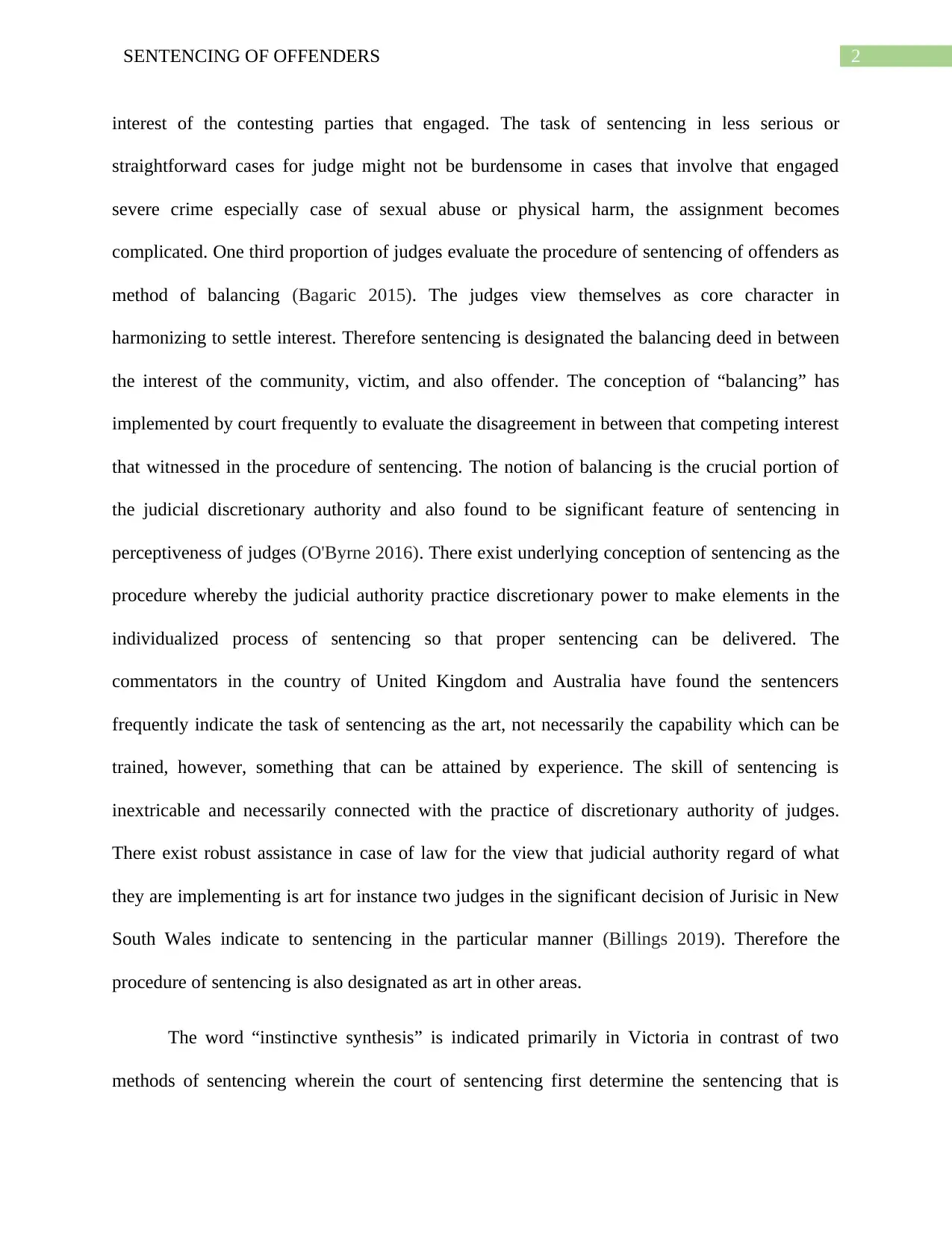
2SENTENCING OF OFFENDERS
interest of the contesting parties that engaged. The task of sentencing in less serious or
straightforward cases for judge might not be burdensome in cases that involve that engaged
severe crime especially case of sexual abuse or physical harm, the assignment becomes
complicated. One third proportion of judges evaluate the procedure of sentencing of offenders as
method of balancing (Bagaric 2015). The judges view themselves as core character in
harmonizing to settle interest. Therefore sentencing is designated the balancing deed in between
the interest of the community, victim, and also offender. The conception of “balancing” has
implemented by court frequently to evaluate the disagreement in between that competing interest
that witnessed in the procedure of sentencing. The notion of balancing is the crucial portion of
the judicial discretionary authority and also found to be significant feature of sentencing in
perceptiveness of judges (O'Byrne 2016). There exist underlying conception of sentencing as the
procedure whereby the judicial authority practice discretionary power to make elements in the
individualized process of sentencing so that proper sentencing can be delivered. The
commentators in the country of United Kingdom and Australia have found the sentencers
frequently indicate the task of sentencing as the art, not necessarily the capability which can be
trained, however, something that can be attained by experience. The skill of sentencing is
inextricable and necessarily connected with the practice of discretionary authority of judges.
There exist robust assistance in case of law for the view that judicial authority regard of what
they are implementing is art for instance two judges in the significant decision of Jurisic in New
South Wales indicate to sentencing in the particular manner (Billings 2019). Therefore the
procedure of sentencing is also designated as art in other areas.
The word “instinctive synthesis” is indicated primarily in Victoria in contrast of two
methods of sentencing wherein the court of sentencing first determine the sentencing that is
interest of the contesting parties that engaged. The task of sentencing in less serious or
straightforward cases for judge might not be burdensome in cases that involve that engaged
severe crime especially case of sexual abuse or physical harm, the assignment becomes
complicated. One third proportion of judges evaluate the procedure of sentencing of offenders as
method of balancing (Bagaric 2015). The judges view themselves as core character in
harmonizing to settle interest. Therefore sentencing is designated the balancing deed in between
the interest of the community, victim, and also offender. The conception of “balancing” has
implemented by court frequently to evaluate the disagreement in between that competing interest
that witnessed in the procedure of sentencing. The notion of balancing is the crucial portion of
the judicial discretionary authority and also found to be significant feature of sentencing in
perceptiveness of judges (O'Byrne 2016). There exist underlying conception of sentencing as the
procedure whereby the judicial authority practice discretionary power to make elements in the
individualized process of sentencing so that proper sentencing can be delivered. The
commentators in the country of United Kingdom and Australia have found the sentencers
frequently indicate the task of sentencing as the art, not necessarily the capability which can be
trained, however, something that can be attained by experience. The skill of sentencing is
inextricable and necessarily connected with the practice of discretionary authority of judges.
There exist robust assistance in case of law for the view that judicial authority regard of what
they are implementing is art for instance two judges in the significant decision of Jurisic in New
South Wales indicate to sentencing in the particular manner (Billings 2019). Therefore the
procedure of sentencing is also designated as art in other areas.
The word “instinctive synthesis” is indicated primarily in Victoria in contrast of two
methods of sentencing wherein the court of sentencing first determine the sentencing that is
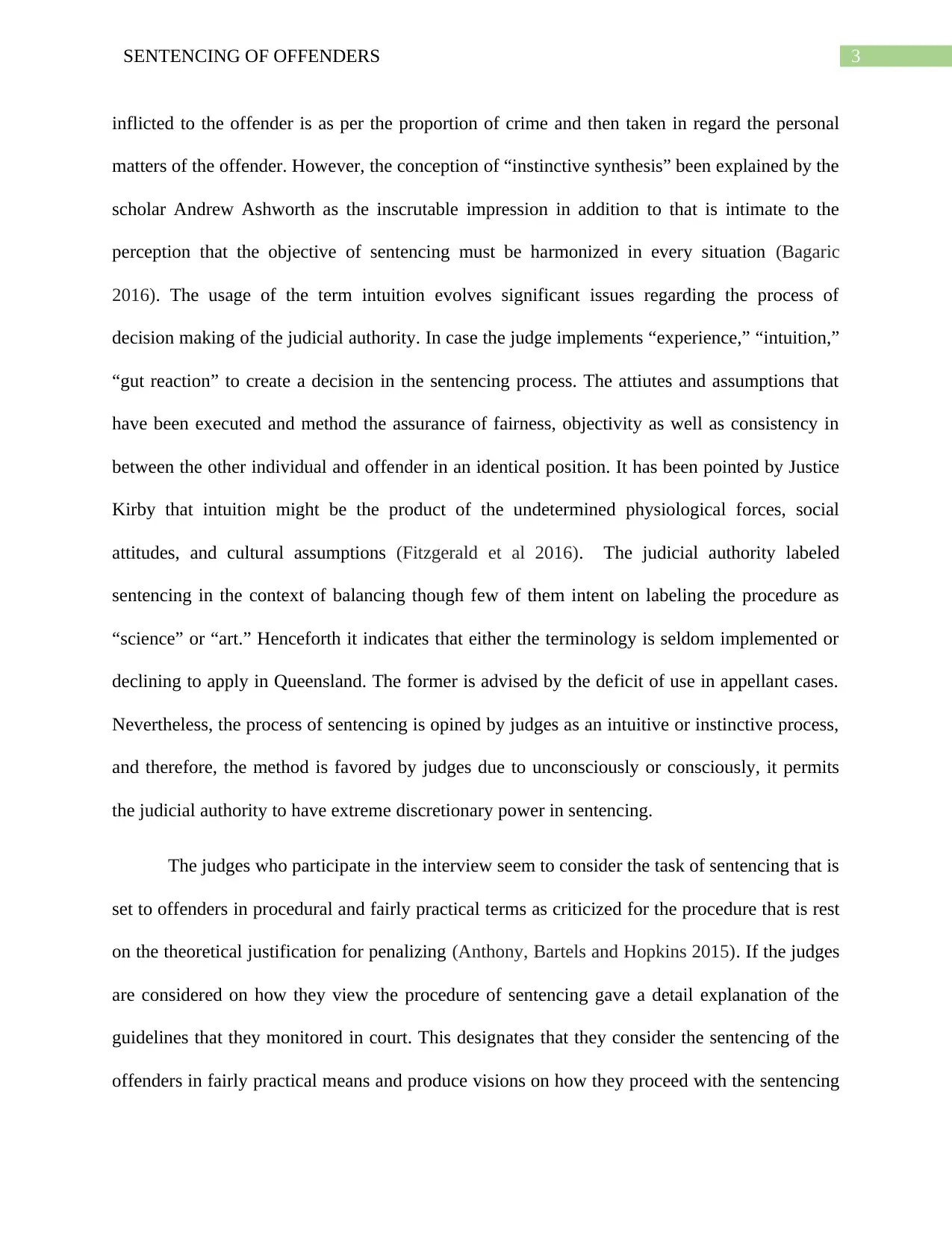
3SENTENCING OF OFFENDERS
inflicted to the offender is as per the proportion of crime and then taken in regard the personal
matters of the offender. However, the conception of “instinctive synthesis” been explained by the
scholar Andrew Ashworth as the inscrutable impression in addition to that is intimate to the
perception that the objective of sentencing must be harmonized in every situation (Bagaric
2016). The usage of the term intuition evolves significant issues regarding the process of
decision making of the judicial authority. In case the judge implements “experience,” “intuition,”
“gut reaction” to create a decision in the sentencing process. The attiutes and assumptions that
have been executed and method the assurance of fairness, objectivity as well as consistency in
between the other individual and offender in an identical position. It has been pointed by Justice
Kirby that intuition might be the product of the undetermined physiological forces, social
attitudes, and cultural assumptions (Fitzgerald et al 2016). The judicial authority labeled
sentencing in the context of balancing though few of them intent on labeling the procedure as
“science” or “art.” Henceforth it indicates that either the terminology is seldom implemented or
declining to apply in Queensland. The former is advised by the deficit of use in appellant cases.
Nevertheless, the process of sentencing is opined by judges as an intuitive or instinctive process,
and therefore, the method is favored by judges due to unconsciously or consciously, it permits
the judicial authority to have extreme discretionary power in sentencing.
The judges who participate in the interview seem to consider the task of sentencing that is
set to offenders in procedural and fairly practical terms as criticized for the procedure that is rest
on the theoretical justification for penalizing (Anthony, Bartels and Hopkins 2015). If the judges
are considered on how they view the procedure of sentencing gave a detail explanation of the
guidelines that they monitored in court. This designates that they consider the sentencing of the
offenders in fairly practical means and produce visions on how they proceed with the sentencing
inflicted to the offender is as per the proportion of crime and then taken in regard the personal
matters of the offender. However, the conception of “instinctive synthesis” been explained by the
scholar Andrew Ashworth as the inscrutable impression in addition to that is intimate to the
perception that the objective of sentencing must be harmonized in every situation (Bagaric
2016). The usage of the term intuition evolves significant issues regarding the process of
decision making of the judicial authority. In case the judge implements “experience,” “intuition,”
“gut reaction” to create a decision in the sentencing process. The attiutes and assumptions that
have been executed and method the assurance of fairness, objectivity as well as consistency in
between the other individual and offender in an identical position. It has been pointed by Justice
Kirby that intuition might be the product of the undetermined physiological forces, social
attitudes, and cultural assumptions (Fitzgerald et al 2016). The judicial authority labeled
sentencing in the context of balancing though few of them intent on labeling the procedure as
“science” or “art.” Henceforth it indicates that either the terminology is seldom implemented or
declining to apply in Queensland. The former is advised by the deficit of use in appellant cases.
Nevertheless, the process of sentencing is opined by judges as an intuitive or instinctive process,
and therefore, the method is favored by judges due to unconsciously or consciously, it permits
the judicial authority to have extreme discretionary power in sentencing.
The judges who participate in the interview seem to consider the task of sentencing that is
set to offenders in procedural and fairly practical terms as criticized for the procedure that is rest
on the theoretical justification for penalizing (Anthony, Bartels and Hopkins 2015). If the judges
are considered on how they view the procedure of sentencing gave a detail explanation of the
guidelines that they monitored in court. This designates that they consider the sentencing of the
offenders in fairly practical means and produce visions on how they proceed with the sentencing
Secure Best Marks with AI Grader
Need help grading? Try our AI Grader for instant feedback on your assignments.
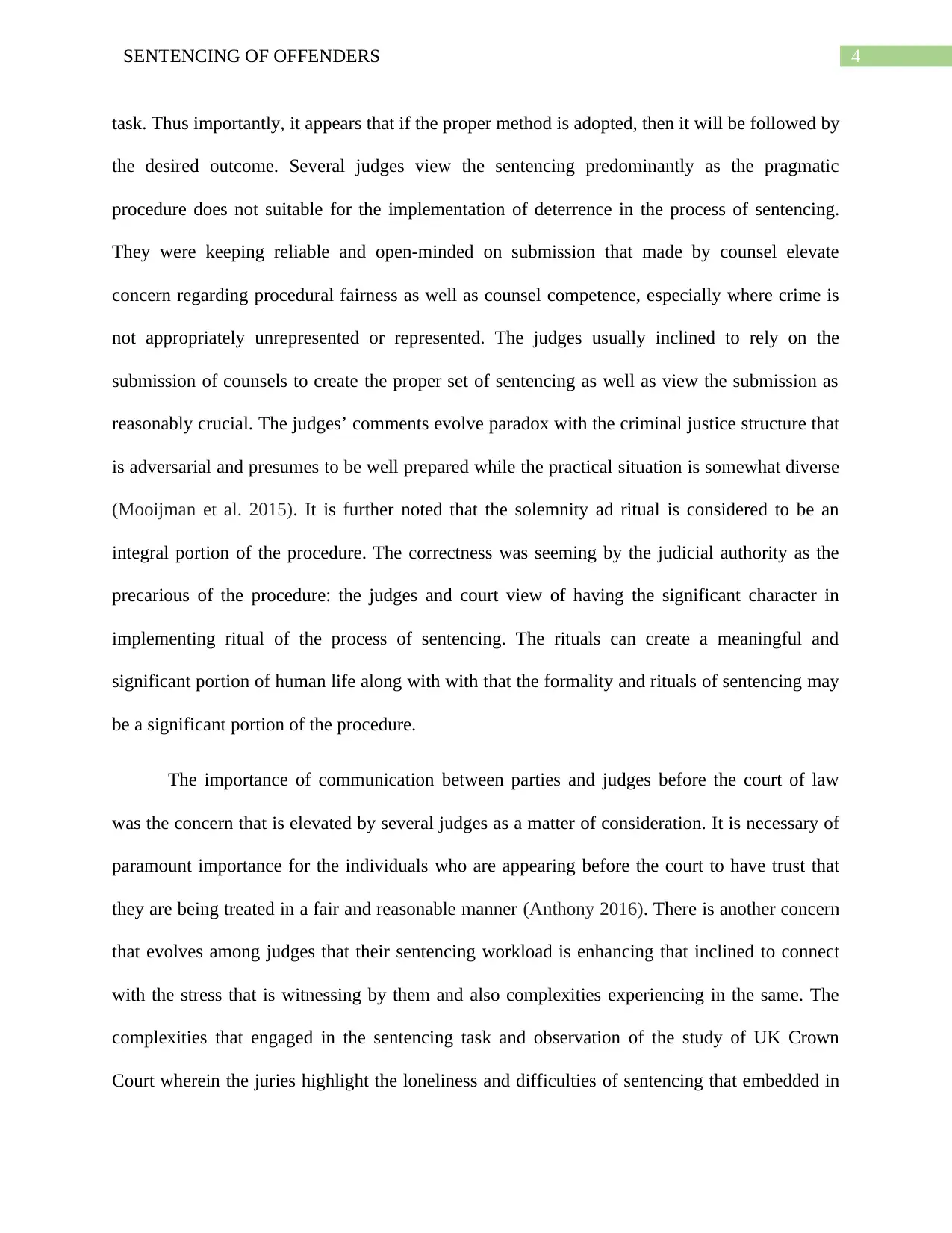
4SENTENCING OF OFFENDERS
task. Thus importantly, it appears that if the proper method is adopted, then it will be followed by
the desired outcome. Several judges view the sentencing predominantly as the pragmatic
procedure does not suitable for the implementation of deterrence in the process of sentencing.
They were keeping reliable and open-minded on submission that made by counsel elevate
concern regarding procedural fairness as well as counsel competence, especially where crime is
not appropriately unrepresented or represented. The judges usually inclined to rely on the
submission of counsels to create the proper set of sentencing as well as view the submission as
reasonably crucial. The judges’ comments evolve paradox with the criminal justice structure that
is adversarial and presumes to be well prepared while the practical situation is somewhat diverse
(Mooijman et al. 2015). It is further noted that the solemnity ad ritual is considered to be an
integral portion of the procedure. The correctness was seeming by the judicial authority as the
precarious of the procedure: the judges and court view of having the significant character in
implementing ritual of the process of sentencing. The rituals can create a meaningful and
significant portion of human life along with with that the formality and rituals of sentencing may
be a significant portion of the procedure.
The importance of communication between parties and judges before the court of law
was the concern that is elevated by several judges as a matter of consideration. It is necessary of
paramount importance for the individuals who are appearing before the court to have trust that
they are being treated in a fair and reasonable manner (Anthony 2016). There is another concern
that evolves among judges that their sentencing workload is enhancing that inclined to connect
with the stress that is witnessing by them and also complexities experiencing in the same. The
complexities that engaged in the sentencing task and observation of the study of UK Crown
Court wherein the juries highlight the loneliness and difficulties of sentencing that embedded in
task. Thus importantly, it appears that if the proper method is adopted, then it will be followed by
the desired outcome. Several judges view the sentencing predominantly as the pragmatic
procedure does not suitable for the implementation of deterrence in the process of sentencing.
They were keeping reliable and open-minded on submission that made by counsel elevate
concern regarding procedural fairness as well as counsel competence, especially where crime is
not appropriately unrepresented or represented. The judges usually inclined to rely on the
submission of counsels to create the proper set of sentencing as well as view the submission as
reasonably crucial. The judges’ comments evolve paradox with the criminal justice structure that
is adversarial and presumes to be well prepared while the practical situation is somewhat diverse
(Mooijman et al. 2015). It is further noted that the solemnity ad ritual is considered to be an
integral portion of the procedure. The correctness was seeming by the judicial authority as the
precarious of the procedure: the judges and court view of having the significant character in
implementing ritual of the process of sentencing. The rituals can create a meaningful and
significant portion of human life along with with that the formality and rituals of sentencing may
be a significant portion of the procedure.
The importance of communication between parties and judges before the court of law
was the concern that is elevated by several judges as a matter of consideration. It is necessary of
paramount importance for the individuals who are appearing before the court to have trust that
they are being treated in a fair and reasonable manner (Anthony 2016). There is another concern
that evolves among judges that their sentencing workload is enhancing that inclined to connect
with the stress that is witnessing by them and also complexities experiencing in the same. The
complexities that engaged in the sentencing task and observation of the study of UK Crown
Court wherein the juries highlight the loneliness and difficulties of sentencing that embedded in
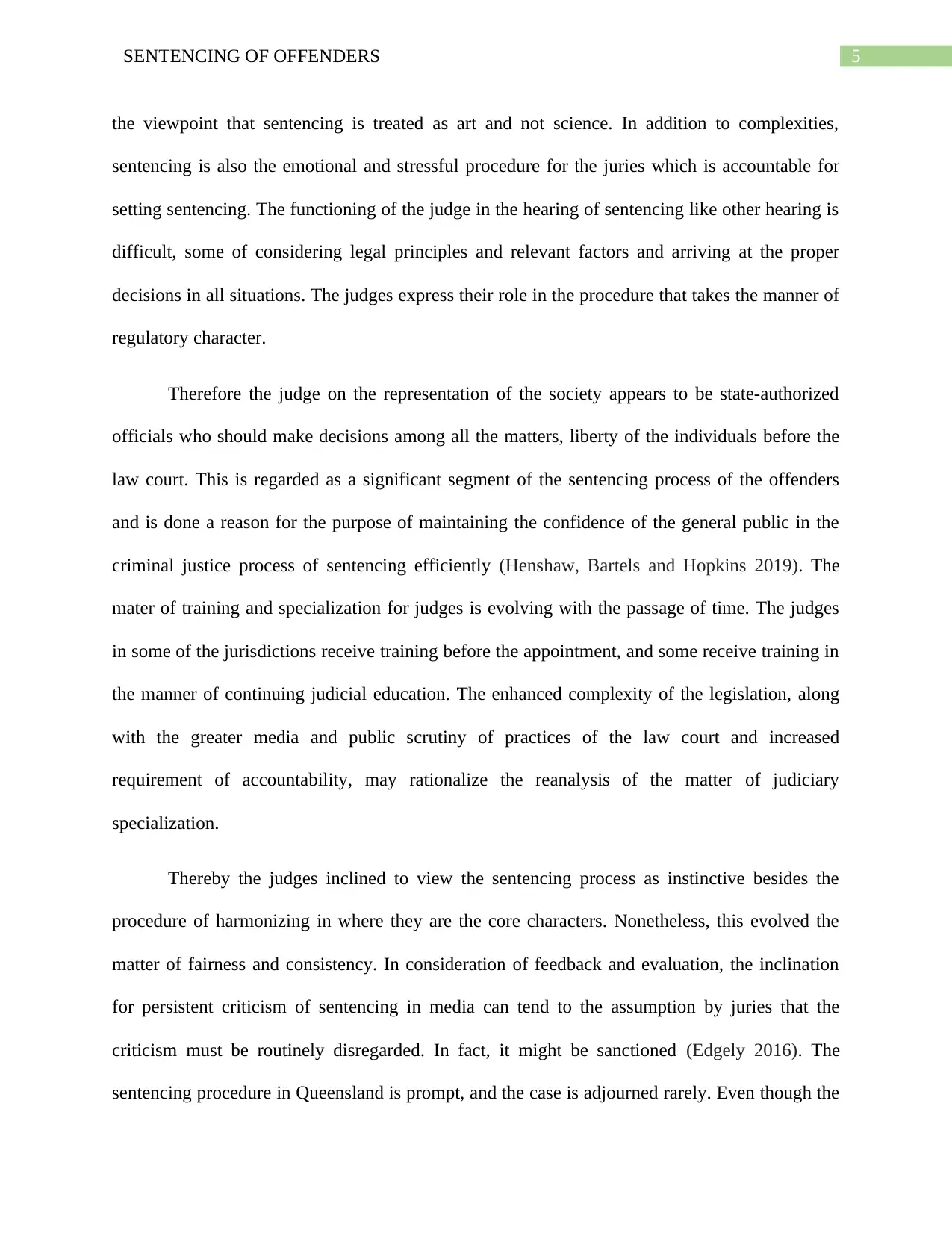
5SENTENCING OF OFFENDERS
the viewpoint that sentencing is treated as art and not science. In addition to complexities,
sentencing is also the emotional and stressful procedure for the juries which is accountable for
setting sentencing. The functioning of the judge in the hearing of sentencing like other hearing is
difficult, some of considering legal principles and relevant factors and arriving at the proper
decisions in all situations. The judges express their role in the procedure that takes the manner of
regulatory character.
Therefore the judge on the representation of the society appears to be state-authorized
officials who should make decisions among all the matters, liberty of the individuals before the
law court. This is regarded as a significant segment of the sentencing process of the offenders
and is done a reason for the purpose of maintaining the confidence of the general public in the
criminal justice process of sentencing efficiently (Henshaw, Bartels and Hopkins 2019). The
mater of training and specialization for judges is evolving with the passage of time. The judges
in some of the jurisdictions receive training before the appointment, and some receive training in
the manner of continuing judicial education. The enhanced complexity of the legislation, along
with the greater media and public scrutiny of practices of the law court and increased
requirement of accountability, may rationalize the reanalysis of the matter of judiciary
specialization.
Thereby the judges inclined to view the sentencing process as instinctive besides the
procedure of harmonizing in where they are the core characters. Nonetheless, this evolved the
matter of fairness and consistency. In consideration of feedback and evaluation, the inclination
for persistent criticism of sentencing in media can tend to the assumption by juries that the
criticism must be routinely disregarded. In fact, it might be sanctioned (Edgely 2016). The
sentencing procedure in Queensland is prompt, and the case is adjourned rarely. Even though the
the viewpoint that sentencing is treated as art and not science. In addition to complexities,
sentencing is also the emotional and stressful procedure for the juries which is accountable for
setting sentencing. The functioning of the judge in the hearing of sentencing like other hearing is
difficult, some of considering legal principles and relevant factors and arriving at the proper
decisions in all situations. The judges express their role in the procedure that takes the manner of
regulatory character.
Therefore the judge on the representation of the society appears to be state-authorized
officials who should make decisions among all the matters, liberty of the individuals before the
law court. This is regarded as a significant segment of the sentencing process of the offenders
and is done a reason for the purpose of maintaining the confidence of the general public in the
criminal justice process of sentencing efficiently (Henshaw, Bartels and Hopkins 2019). The
mater of training and specialization for judges is evolving with the passage of time. The judges
in some of the jurisdictions receive training before the appointment, and some receive training in
the manner of continuing judicial education. The enhanced complexity of the legislation, along
with the greater media and public scrutiny of practices of the law court and increased
requirement of accountability, may rationalize the reanalysis of the matter of judiciary
specialization.
Thereby the judges inclined to view the sentencing process as instinctive besides the
procedure of harmonizing in where they are the core characters. Nonetheless, this evolved the
matter of fairness and consistency. In consideration of feedback and evaluation, the inclination
for persistent criticism of sentencing in media can tend to the assumption by juries that the
criticism must be routinely disregarded. In fact, it might be sanctioned (Edgely 2016). The
sentencing procedure in Queensland is prompt, and the case is adjourned rarely. Even though the
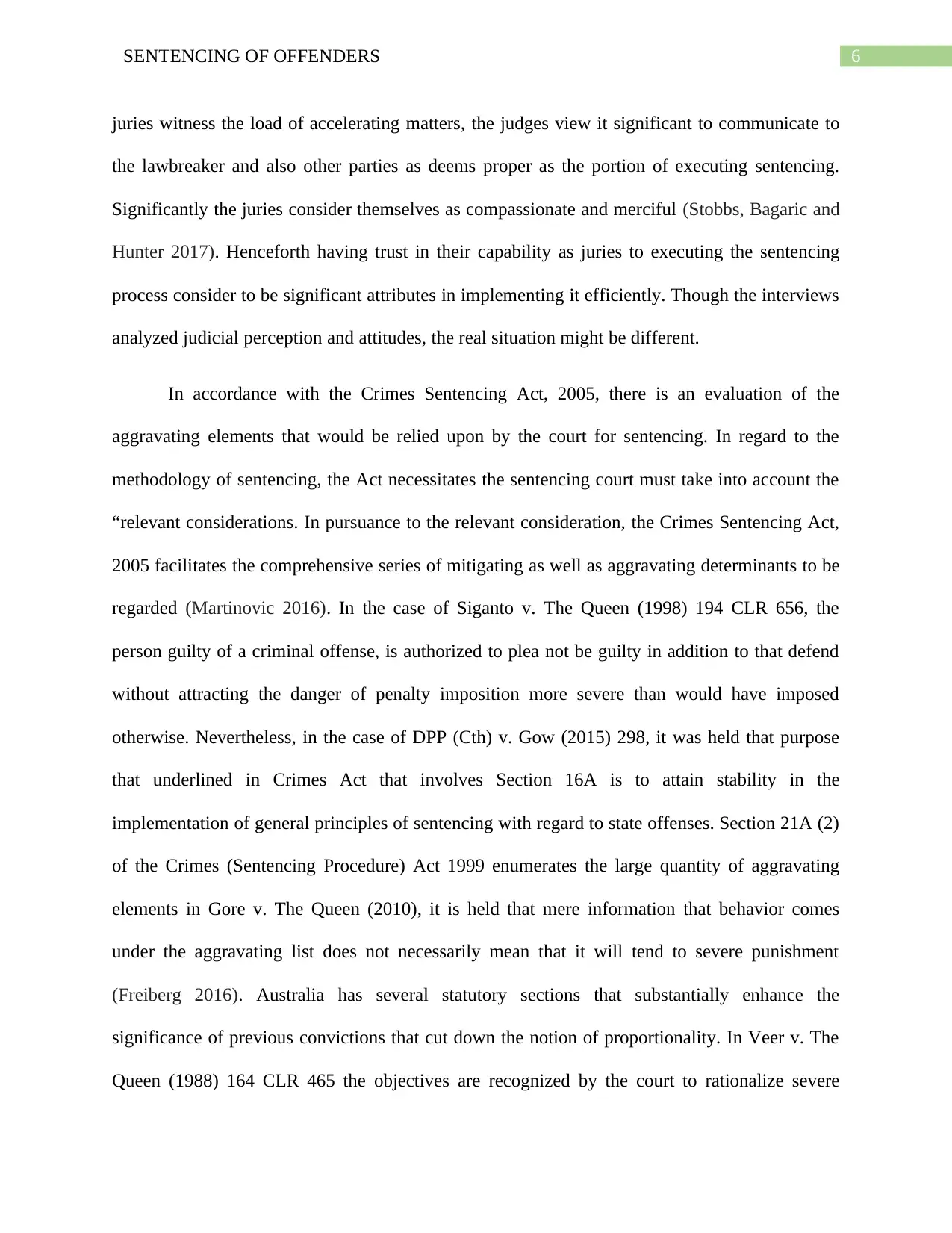
6SENTENCING OF OFFENDERS
juries witness the load of accelerating matters, the judges view it significant to communicate to
the lawbreaker and also other parties as deems proper as the portion of executing sentencing.
Significantly the juries consider themselves as compassionate and merciful (Stobbs, Bagaric and
Hunter 2017). Henceforth having trust in their capability as juries to executing the sentencing
process consider to be significant attributes in implementing it efficiently. Though the interviews
analyzed judicial perception and attitudes, the real situation might be different.
In accordance with the Crimes Sentencing Act, 2005, there is an evaluation of the
aggravating elements that would be relied upon by the court for sentencing. In regard to the
methodology of sentencing, the Act necessitates the sentencing court must take into account the
“relevant considerations. In pursuance to the relevant consideration, the Crimes Sentencing Act,
2005 facilitates the comprehensive series of mitigating as well as aggravating determinants to be
regarded (Martinovic 2016). In the case of Siganto v. The Queen (1998) 194 CLR 656, the
person guilty of a criminal offense, is authorized to plea not be guilty in addition to that defend
without attracting the danger of penalty imposition more severe than would have imposed
otherwise. Nevertheless, in the case of DPP (Cth) v. Gow (2015) 298, it was held that purpose
that underlined in Crimes Act that involves Section 16A is to attain stability in the
implementation of general principles of sentencing with regard to state offenses. Section 21A (2)
of the Crimes (Sentencing Procedure) Act 1999 enumerates the large quantity of aggravating
elements in Gore v. The Queen (2010), it is held that mere information that behavior comes
under the aggravating list does not necessarily mean that it will tend to severe punishment
(Freiberg 2016). Australia has several statutory sections that substantially enhance the
significance of previous convictions that cut down the notion of proportionality. In Veer v. The
Queen (1988) 164 CLR 465 the objectives are recognized by the court to rationalize severe
juries witness the load of accelerating matters, the judges view it significant to communicate to
the lawbreaker and also other parties as deems proper as the portion of executing sentencing.
Significantly the juries consider themselves as compassionate and merciful (Stobbs, Bagaric and
Hunter 2017). Henceforth having trust in their capability as juries to executing the sentencing
process consider to be significant attributes in implementing it efficiently. Though the interviews
analyzed judicial perception and attitudes, the real situation might be different.
In accordance with the Crimes Sentencing Act, 2005, there is an evaluation of the
aggravating elements that would be relied upon by the court for sentencing. In regard to the
methodology of sentencing, the Act necessitates the sentencing court must take into account the
“relevant considerations. In pursuance to the relevant consideration, the Crimes Sentencing Act,
2005 facilitates the comprehensive series of mitigating as well as aggravating determinants to be
regarded (Martinovic 2016). In the case of Siganto v. The Queen (1998) 194 CLR 656, the
person guilty of a criminal offense, is authorized to plea not be guilty in addition to that defend
without attracting the danger of penalty imposition more severe than would have imposed
otherwise. Nevertheless, in the case of DPP (Cth) v. Gow (2015) 298, it was held that purpose
that underlined in Crimes Act that involves Section 16A is to attain stability in the
implementation of general principles of sentencing with regard to state offenses. Section 21A (2)
of the Crimes (Sentencing Procedure) Act 1999 enumerates the large quantity of aggravating
elements in Gore v. The Queen (2010), it is held that mere information that behavior comes
under the aggravating list does not necessarily mean that it will tend to severe punishment
(Freiberg 2016). Australia has several statutory sections that substantially enhance the
significance of previous convictions that cut down the notion of proportionality. In Veer v. The
Queen (1988) 164 CLR 465 the objectives are recognized by the court to rationalize severe
Paraphrase This Document
Need a fresh take? Get an instant paraphrase of this document with our AI Paraphraser
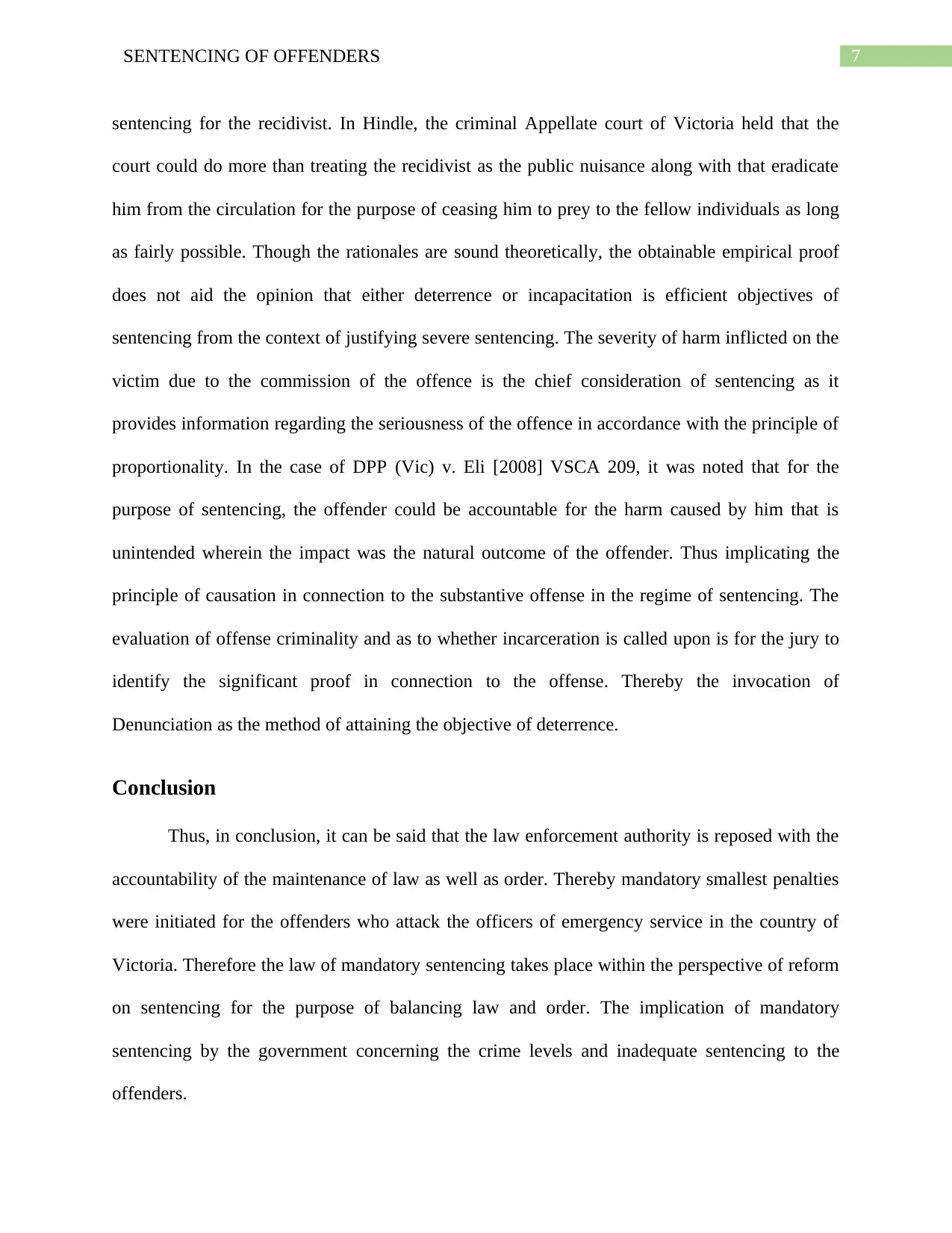
7SENTENCING OF OFFENDERS
sentencing for the recidivist. In Hindle, the criminal Appellate court of Victoria held that the
court could do more than treating the recidivist as the public nuisance along with that eradicate
him from the circulation for the purpose of ceasing him to prey to the fellow individuals as long
as fairly possible. Though the rationales are sound theoretically, the obtainable empirical proof
does not aid the opinion that either deterrence or incapacitation is efficient objectives of
sentencing from the context of justifying severe sentencing. The severity of harm inflicted on the
victim due to the commission of the offence is the chief consideration of sentencing as it
provides information regarding the seriousness of the offence in accordance with the principle of
proportionality. In the case of DPP (Vic) v. Eli [2008] VSCA 209, it was noted that for the
purpose of sentencing, the offender could be accountable for the harm caused by him that is
unintended wherein the impact was the natural outcome of the offender. Thus implicating the
principle of causation in connection to the substantive offense in the regime of sentencing. The
evaluation of offense criminality and as to whether incarceration is called upon is for the jury to
identify the significant proof in connection to the offense. Thereby the invocation of
Denunciation as the method of attaining the objective of deterrence.
Conclusion
Thus, in conclusion, it can be said that the law enforcement authority is reposed with the
accountability of the maintenance of law as well as order. Thereby mandatory smallest penalties
were initiated for the offenders who attack the officers of emergency service in the country of
Victoria. Therefore the law of mandatory sentencing takes place within the perspective of reform
on sentencing for the purpose of balancing law and order. The implication of mandatory
sentencing by the government concerning the crime levels and inadequate sentencing to the
offenders.
sentencing for the recidivist. In Hindle, the criminal Appellate court of Victoria held that the
court could do more than treating the recidivist as the public nuisance along with that eradicate
him from the circulation for the purpose of ceasing him to prey to the fellow individuals as long
as fairly possible. Though the rationales are sound theoretically, the obtainable empirical proof
does not aid the opinion that either deterrence or incapacitation is efficient objectives of
sentencing from the context of justifying severe sentencing. The severity of harm inflicted on the
victim due to the commission of the offence is the chief consideration of sentencing as it
provides information regarding the seriousness of the offence in accordance with the principle of
proportionality. In the case of DPP (Vic) v. Eli [2008] VSCA 209, it was noted that for the
purpose of sentencing, the offender could be accountable for the harm caused by him that is
unintended wherein the impact was the natural outcome of the offender. Thus implicating the
principle of causation in connection to the substantive offense in the regime of sentencing. The
evaluation of offense criminality and as to whether incarceration is called upon is for the jury to
identify the significant proof in connection to the offense. Thereby the invocation of
Denunciation as the method of attaining the objective of deterrence.
Conclusion
Thus, in conclusion, it can be said that the law enforcement authority is reposed with the
accountability of the maintenance of law as well as order. Thereby mandatory smallest penalties
were initiated for the offenders who attack the officers of emergency service in the country of
Victoria. Therefore the law of mandatory sentencing takes place within the perspective of reform
on sentencing for the purpose of balancing law and order. The implication of mandatory
sentencing by the government concerning the crime levels and inadequate sentencing to the
offenders.
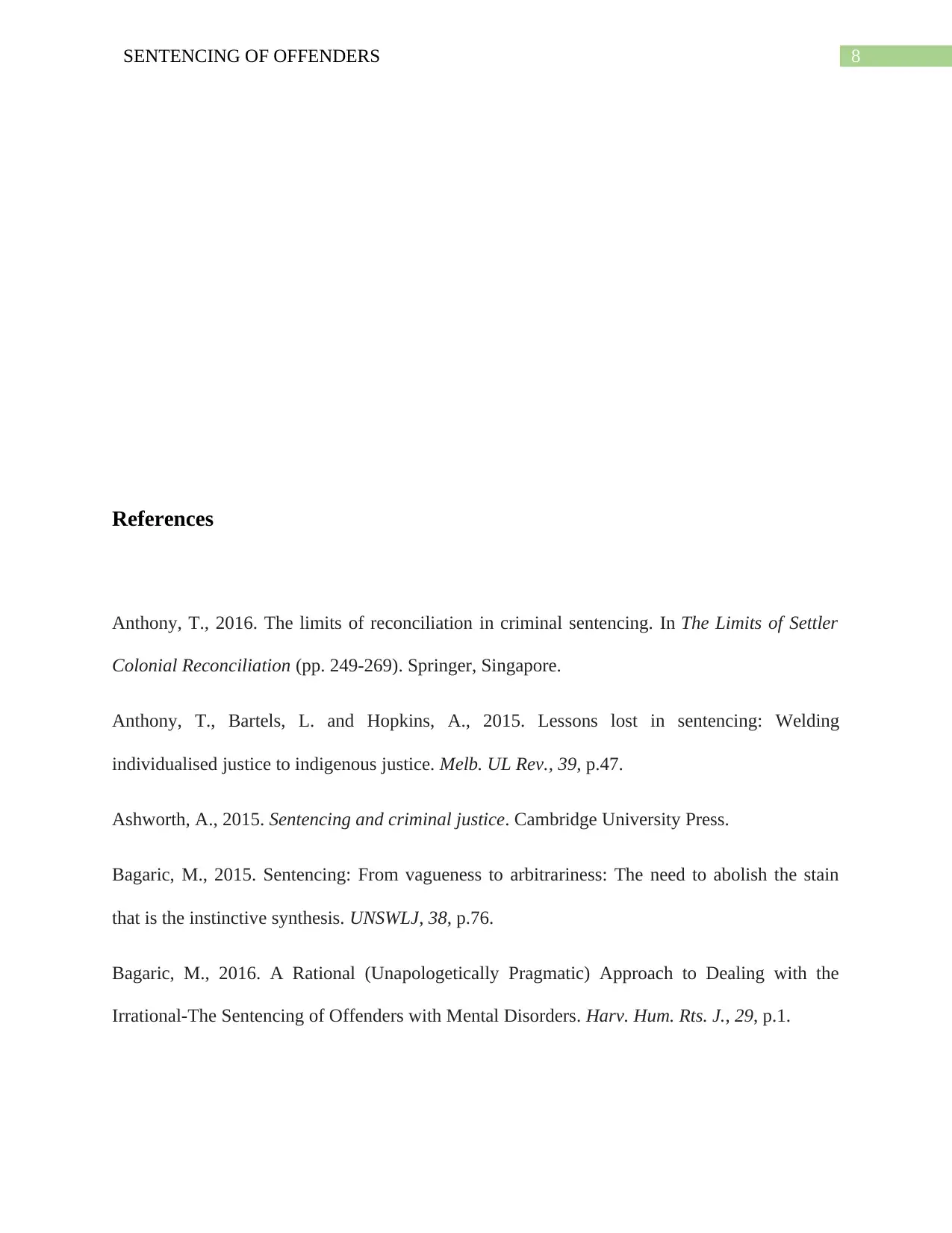
8SENTENCING OF OFFENDERS
References
Anthony, T., 2016. The limits of reconciliation in criminal sentencing. In The Limits of Settler
Colonial Reconciliation (pp. 249-269). Springer, Singapore.
Anthony, T., Bartels, L. and Hopkins, A., 2015. Lessons lost in sentencing: Welding
individualised justice to indigenous justice. Melb. UL Rev., 39, p.47.
Ashworth, A., 2015. Sentencing and criminal justice. Cambridge University Press.
Bagaric, M., 2015. Sentencing: From vagueness to arbitrariness: The need to abolish the stain
that is the instinctive synthesis. UNSWLJ, 38, p.76.
Bagaric, M., 2016. A Rational (Unapologetically Pragmatic) Approach to Dealing with the
Irrational-The Sentencing of Offenders with Mental Disorders. Harv. Hum. Rts. J., 29, p.1.
References
Anthony, T., 2016. The limits of reconciliation in criminal sentencing. In The Limits of Settler
Colonial Reconciliation (pp. 249-269). Springer, Singapore.
Anthony, T., Bartels, L. and Hopkins, A., 2015. Lessons lost in sentencing: Welding
individualised justice to indigenous justice. Melb. UL Rev., 39, p.47.
Ashworth, A., 2015. Sentencing and criminal justice. Cambridge University Press.
Bagaric, M., 2015. Sentencing: From vagueness to arbitrariness: The need to abolish the stain
that is the instinctive synthesis. UNSWLJ, 38, p.76.
Bagaric, M., 2016. A Rational (Unapologetically Pragmatic) Approach to Dealing with the
Irrational-The Sentencing of Offenders with Mental Disorders. Harv. Hum. Rts. J., 29, p.1.
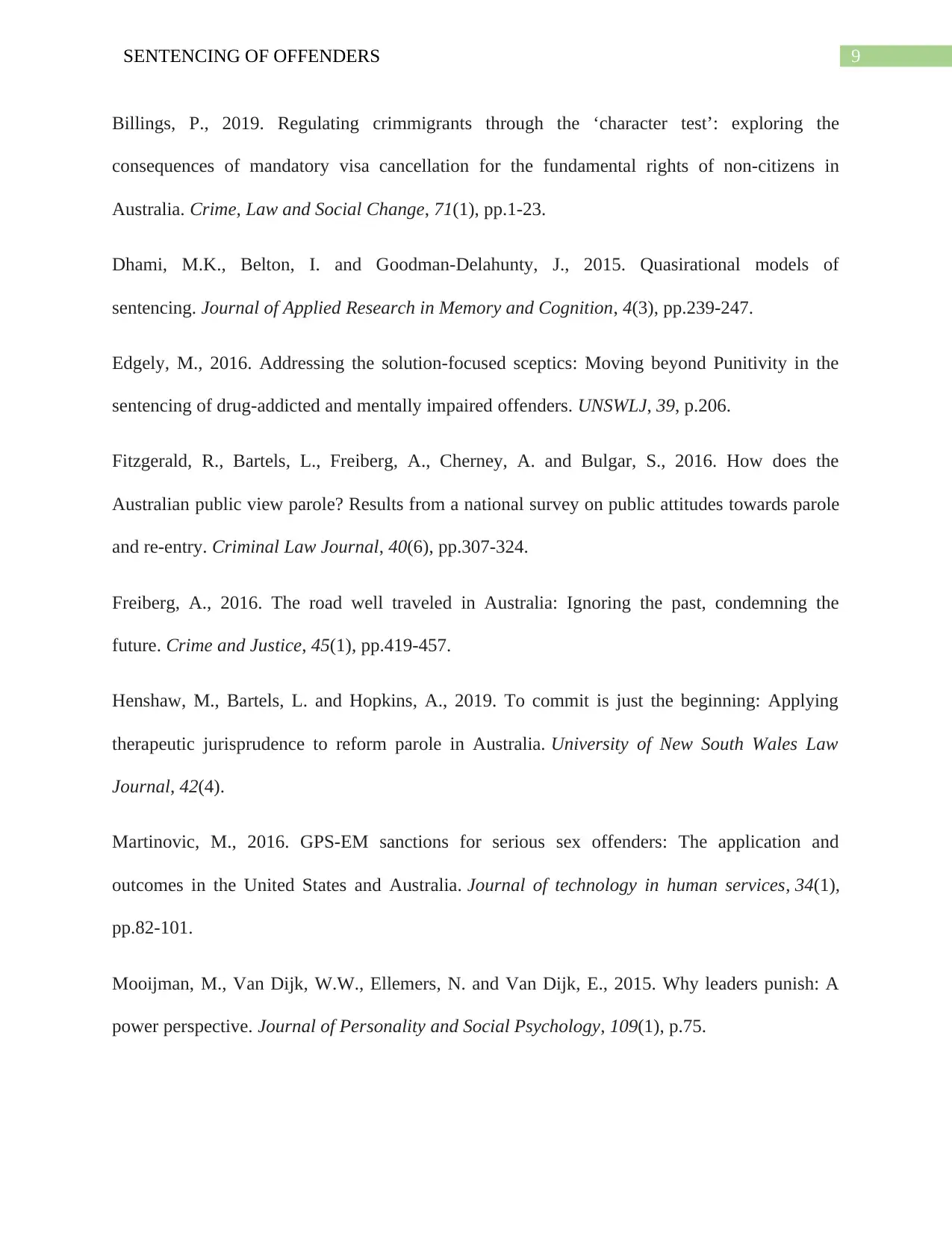
9SENTENCING OF OFFENDERS
Billings, P., 2019. Regulating crimmigrants through the ‘character test’: exploring the
consequences of mandatory visa cancellation for the fundamental rights of non-citizens in
Australia. Crime, Law and Social Change, 71(1), pp.1-23.
Dhami, M.K., Belton, I. and Goodman-Delahunty, J., 2015. Quasirational models of
sentencing. Journal of Applied Research in Memory and Cognition, 4(3), pp.239-247.
Edgely, M., 2016. Addressing the solution-focused sceptics: Moving beyond Punitivity in the
sentencing of drug-addicted and mentally impaired offenders. UNSWLJ, 39, p.206.
Fitzgerald, R., Bartels, L., Freiberg, A., Cherney, A. and Bulgar, S., 2016. How does the
Australian public view parole? Results from a national survey on public attitudes towards parole
and re-entry. Criminal Law Journal, 40(6), pp.307-324.
Freiberg, A., 2016. The road well traveled in Australia: Ignoring the past, condemning the
future. Crime and Justice, 45(1), pp.419-457.
Henshaw, M., Bartels, L. and Hopkins, A., 2019. To commit is just the beginning: Applying
therapeutic jurisprudence to reform parole in Australia. University of New South Wales Law
Journal, 42(4).
Martinovic, M., 2016. GPS-EM sanctions for serious sex offenders: The application and
outcomes in the United States and Australia. Journal of technology in human services, 34(1),
pp.82-101.
Mooijman, M., Van Dijk, W.W., Ellemers, N. and Van Dijk, E., 2015. Why leaders punish: A
power perspective. Journal of Personality and Social Psychology, 109(1), p.75.
Billings, P., 2019. Regulating crimmigrants through the ‘character test’: exploring the
consequences of mandatory visa cancellation for the fundamental rights of non-citizens in
Australia. Crime, Law and Social Change, 71(1), pp.1-23.
Dhami, M.K., Belton, I. and Goodman-Delahunty, J., 2015. Quasirational models of
sentencing. Journal of Applied Research in Memory and Cognition, 4(3), pp.239-247.
Edgely, M., 2016. Addressing the solution-focused sceptics: Moving beyond Punitivity in the
sentencing of drug-addicted and mentally impaired offenders. UNSWLJ, 39, p.206.
Fitzgerald, R., Bartels, L., Freiberg, A., Cherney, A. and Bulgar, S., 2016. How does the
Australian public view parole? Results from a national survey on public attitudes towards parole
and re-entry. Criminal Law Journal, 40(6), pp.307-324.
Freiberg, A., 2016. The road well traveled in Australia: Ignoring the past, condemning the
future. Crime and Justice, 45(1), pp.419-457.
Henshaw, M., Bartels, L. and Hopkins, A., 2019. To commit is just the beginning: Applying
therapeutic jurisprudence to reform parole in Australia. University of New South Wales Law
Journal, 42(4).
Martinovic, M., 2016. GPS-EM sanctions for serious sex offenders: The application and
outcomes in the United States and Australia. Journal of technology in human services, 34(1),
pp.82-101.
Mooijman, M., Van Dijk, W.W., Ellemers, N. and Van Dijk, E., 2015. Why leaders punish: A
power perspective. Journal of Personality and Social Psychology, 109(1), p.75.
Secure Best Marks with AI Grader
Need help grading? Try our AI Grader for instant feedback on your assignments.
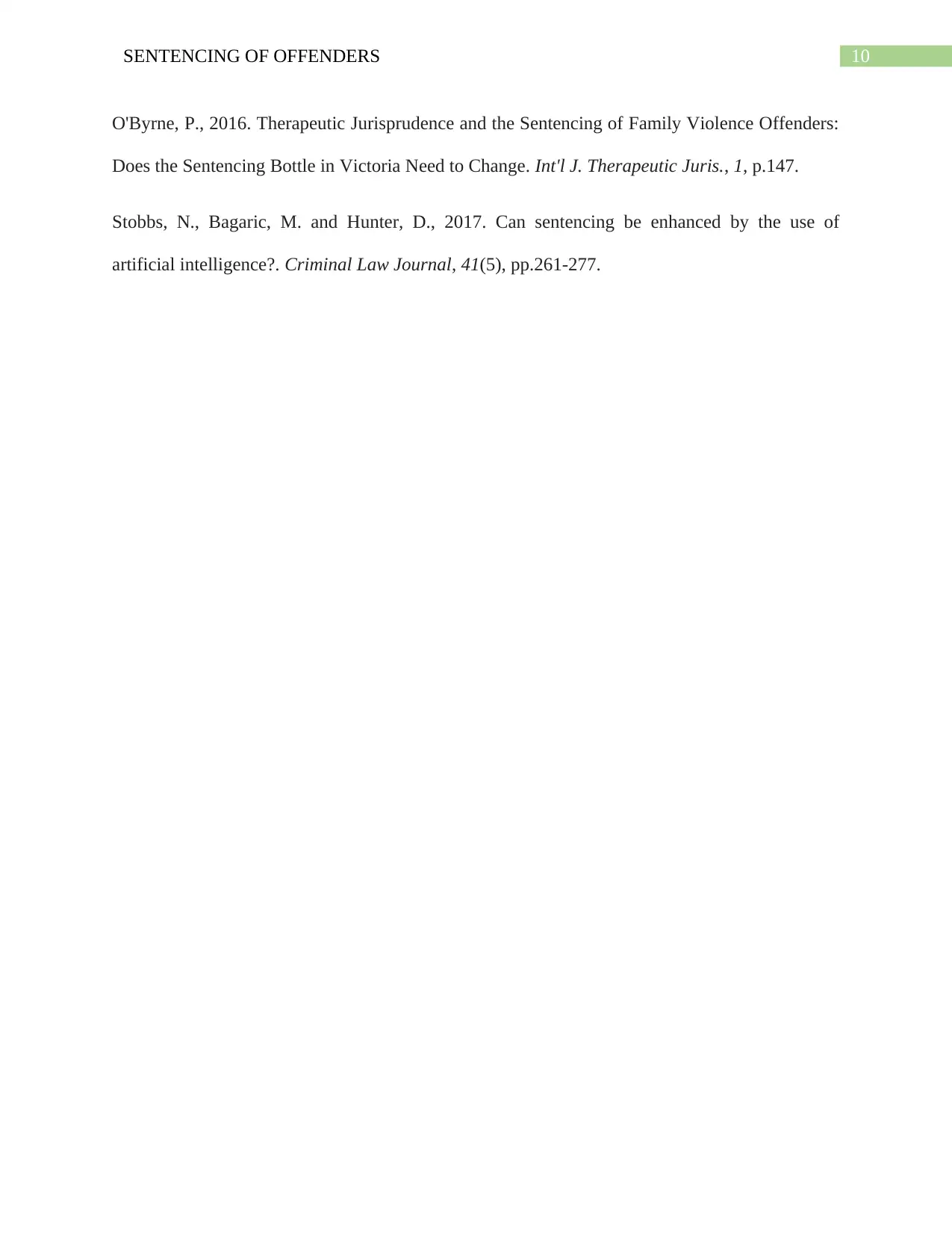
10SENTENCING OF OFFENDERS
O'Byrne, P., 2016. Therapeutic Jurisprudence and the Sentencing of Family Violence Offenders:
Does the Sentencing Bottle in Victoria Need to Change. Int'l J. Therapeutic Juris., 1, p.147.
Stobbs, N., Bagaric, M. and Hunter, D., 2017. Can sentencing be enhanced by the use of
artificial intelligence?. Criminal Law Journal, 41(5), pp.261-277.
O'Byrne, P., 2016. Therapeutic Jurisprudence and the Sentencing of Family Violence Offenders:
Does the Sentencing Bottle in Victoria Need to Change. Int'l J. Therapeutic Juris., 1, p.147.
Stobbs, N., Bagaric, M. and Hunter, D., 2017. Can sentencing be enhanced by the use of
artificial intelligence?. Criminal Law Journal, 41(5), pp.261-277.
1 out of 11
Your All-in-One AI-Powered Toolkit for Academic Success.
+13062052269
info@desklib.com
Available 24*7 on WhatsApp / Email
![[object Object]](/_next/static/media/star-bottom.7253800d.svg)
Unlock your academic potential
© 2024 | Zucol Services PVT LTD | All rights reserved.